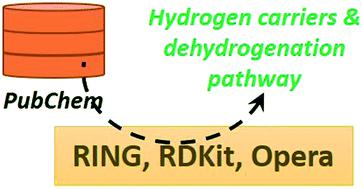当前位置:
X-MOL 学术
›
Mol. Syst. Des. Eng.
›
论文详情
Our official English website, www.x-mol.net, welcomes your feedback! (Note: you will need to create a separate account there.)
A computational workflow to discover novel liquid organic hydrogen carriers and their dehydrogenation routes
Molecular Systems Design & Engineering ( IF 3.6 ) Pub Date : 2020-09-03 , DOI: 10.1039/d0me00105h Kristin Paragian 1, 2, 3, 4 , Bowen Li 1, 2, 3, 4 , Morgan Massino 1, 2, 3, 4 , Srinivas Rangarajan 1, 2, 3, 4
Molecular Systems Design & Engineering ( IF 3.6 ) Pub Date : 2020-09-03 , DOI: 10.1039/d0me00105h Kristin Paragian 1, 2, 3, 4 , Bowen Li 1, 2, 3, 4 , Morgan Massino 1, 2, 3, 4 , Srinivas Rangarajan 1, 2, 3, 4
Affiliation

|
Two-way liquid organic hydrogen carriers (LOHC) – organic molecules that store hydrogen as reversible chemical bonds – is an emerging concept for on-demand storage and transportation of hydrogen (and thereby energy). Given the large chemical universe, a plethora of potential LOHCs exist, however, the optimal candidate depends on satisfying a variety of constraints on physicochemical and thermochemical properties. Computational high-throughput screening of a subspace of this universe can, in principle, reveal several LOHC candidates which can then be experimentally verified; however, to achieve this, the hydrogen rich and lean forms of the LOHC pair have to be simultaneously identified based on a plausible connecting chemical pathway. Here, using a combination of data-driven molecular property models and a cheminformatics-based reaction network generation tool, viz. RING, we develop a novel computational workflow to identify promising LOHC pairs (i.e. hydrogen-rich and hydrogen-lean forms) and the dehydrogenation pathways connecting them. Starting from over 1 million small (containing less than 14 heavy atoms) molecules in the PubChem database as seed, we applied this framework as proof of concept to identify several LOHC pairs that have promising properties in terms of melting point, boiling point, dehydrogenation enthalpy, hydrogen storage capacity, and synthetic accessibility; we further analyze the thermochemistry of dehydrogenation pathways of the top five candidates. We finally show that this screening provides a rich dataset that can be harnessed via supervised learning algorithms to infer descriptive features that determine if a molecule is a good LOHC candidate. We posit that the proposed workflow can be used to scalably analyze a much larger molecular space and multiple classes of dehydrogenation chemistries to discover novel LOHC pairs.
中文翻译:

发现新型液态有机氢载体及其脱氢途径的计算流程
双向液态有机氢载体(LOHC)–将氢存储为可逆化学键的有机分子–是按需存储和运输氢(以及由此产生的能量)的新兴概念。在广阔的化学领域中,存在大量潜在的LOHC,但是,最佳候选物取决于满足对物理化学和热化学性质的各种限制。从原理上讲,该宇宙的子空间的计算高通量筛选可以揭示出若干LOHC候选物,然后可以通过实验进行验证;但是,要实现这一点,必须根据合理的连接化学途径同时确定LOHC对的富氢和贫氢形式。这里,即 RING,我们开发了一种新颖的计算流程来确定有前途的LOHC对(即富氢和贫氢形式)以及连接它们的脱氢途径。从PubChem数据库中的超过一百万个小分子(包含少于14个重原子)作为种子开始,我们将这个框架用作概念验证,以鉴定在熔点,沸点,脱氢焓方面具有良好前景的几对LOHC对,储氢量和合成材料的可及性;我们进一步分析了前五名候选人的脱氢途径的热化学。最后,我们表明,这种筛选提供了丰富的数据集可以被利用通过监督学习算法,以推断出确定分子是否为良好LOHC候选者的描述性特征。我们认为,提出的工作流程可用于可缩放地分析更大的分子空间和多种类型的脱氢化学试剂,以发现新型的LOHC对。
更新日期:2020-11-03
中文翻译:

发现新型液态有机氢载体及其脱氢途径的计算流程
双向液态有机氢载体(LOHC)–将氢存储为可逆化学键的有机分子–是按需存储和运输氢(以及由此产生的能量)的新兴概念。在广阔的化学领域中,存在大量潜在的LOHC,但是,最佳候选物取决于满足对物理化学和热化学性质的各种限制。从原理上讲,该宇宙的子空间的计算高通量筛选可以揭示出若干LOHC候选物,然后可以通过实验进行验证;但是,要实现这一点,必须根据合理的连接化学途径同时确定LOHC对的富氢和贫氢形式。这里,即 RING,我们开发了一种新颖的计算流程来确定有前途的LOHC对(即富氢和贫氢形式)以及连接它们的脱氢途径。从PubChem数据库中的超过一百万个小分子(包含少于14个重原子)作为种子开始,我们将这个框架用作概念验证,以鉴定在熔点,沸点,脱氢焓方面具有良好前景的几对LOHC对,储氢量和合成材料的可及性;我们进一步分析了前五名候选人的脱氢途径的热化学。最后,我们表明,这种筛选提供了丰富的数据集可以被利用通过监督学习算法,以推断出确定分子是否为良好LOHC候选者的描述性特征。我们认为,提出的工作流程可用于可缩放地分析更大的分子空间和多种类型的脱氢化学试剂,以发现新型的LOHC对。



























 京公网安备 11010802027423号
京公网安备 11010802027423号